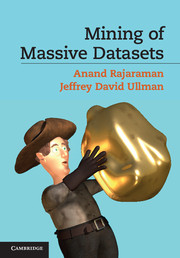Preface
Summary
This book evolved from material developed over several years by Anand Rajaraman and Jeff Ullman for a one-quarter course at Stanford. The course CS345A, titled “Web Mining,” was designed as an advanced graduate course, although it has become accessible and interesting to advanced undergraduates.
What the Book Is About
At the highest level of description, this book is about data mining. However, it focuses on data mining of very large amounts of data, that is, data so large it does not fit in main memory. Because of the emphasis on size, many of our examples are about the Web or data derived from the Web. Further, the book takes an algorithmic point of view: data mining is about applying algorithms to data, rather than using data to “train” a machine-learning engine of some sort. The principal topics covered are:
(1) Distributed file systems and map-reduce as a tool for creating parallel algorithms that succeed on very large amounts of data.
(2) Similarity search, including the key techniques of minhashing and locality-sensitive hashing.
(3) Data-stream processing and specialized algorithms for dealing with data that arrives so fast it must be processed immediately or lost.
(4) The technology of search engines, including Google's PageRank, link-spam detection, and the hubs-and-authorities approach.
(5) Frequent-itemset mining, including association rules, market-baskets, the APriori Algorithm and its improvements.
(6) Algorithms for clustering very large, high-dimensional datasets.
(7) Two key problems for Web applications: managing advertising and recommendation systems.
- Type
- Chapter
- Information
- Mining of Massive Datasets , pp. ix - xPublisher: Cambridge University PressPrint publication year: 2011



